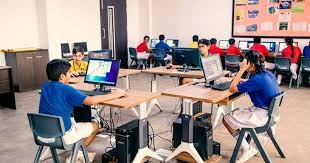Introduction: The Digital Transformation of Education
The landscape of education has undergone a remarkable transformation over the past decade, with tech playing an increasingly central role in how knowledge is imparted and received. This digital revolution has redefined traditional teaching methodologies, introducing innovative tools and platforms that enhance the learning experience. From interactive smartboards to artificial intelligence-powered learning applications, technology has become an indispensable component of modern education, reshaping how students engage with content and how educators deliver instruction.
The Impact of Digital Tools on Learning Outcomes
The integration of digital tools in educational settings has shown promising results in improving student engagement and academic performance. Research indicates that technology-enhanced learning environments can increase student motivation by up to 40% when implemented effectively. These digital resources provide personalized learning experiences, adapting to individual student needs and learning paces, which traditional one-size-fits-all approaches often fail to address.
The Changing Role of Educators
As technology reshapes the educational landscape, the role of teachers has evolved significantly from mere knowledge dispensers to facilitators of learning experiences. Modern educators navigate a complex ecosystem of digital tools while maintaining the human connection essential for effective education. They curate content, design technology-enhanced learning activities, and guide students through the digital maze, all while developing crucial critical thinking skills that technology alone cannot foster.
Bridging the Digital Divide in Education
Despite the promising potential of educational technology, significant challenges remain in ensuring equitable access across different socioeconomic backgrounds. The digital divide continues to be a pressing concern, with approximately 16 million K-12 public school students lacking adequate internet access or devices for online learning. Addressing this inequity requires concentrated efforts from educational institutions, policymakers, and technology providers to create sustainable solutions that democratize access to digital learning resources.
Emerging Technologies Shaping Future Classrooms
Artificial Intelligence in Education
The application of artificial intelligence in educational settings represents one of the most promising frontiers in edtech innovation. AI-powered systems can analyze student performance data to identify learning patterns, predict areas where students might struggle, and recommend personalized intervention strategies. These capabilities enable more effective differentiated instruction, allowing educators to address individual student needs more precisely than ever before.
Virtual and Augmented Reality Learning Environments
Immersive technologies like virtual reality (VR) and augmented reality (AR) are transforming abstract concepts into tangible experiences. History students can virtually walk through ancient civilizations, science classes can explore the human body in three dimensions, and geography lessons can transport students to distant landscapes. These technologies bridge the gap between theoretical knowledge and practical understanding, creating memorable learning experiences that significantly enhance knowledge retention.
Gamification and Game-Based Learning
The integration of game elements into educational contexts has proven highly effective in boosting student engagement and motivation. Gamification leverages the intrinsic reward systems that make games compelling and applies them to learning objectives, transforming potentially mundane educational tasks into engaging challenges. This approach has shown particular promise in subjects that students traditionally find challenging or uninteresting.
Data-Driven Teaching Methodologies
The proliferation of educational technology has generated unprecedented amounts of learning data, enabling evidence-based teaching approaches. Modern educational platforms track student progress in real-time, providing educators with actionable insights into learning patterns, strengths, and areas for improvement. This data-driven approach allows for more targeted interventions and continuous refinement of teaching strategies based on empirical evidence rather than intuition.
Building Digital Literacy Among Educators and Students
For educational technology to reach its full potential, both teachers and students must develop robust digital literacy skills. This encompasses not only the technical proficiency to operate various digital tools but also the critical thinking abilities to evaluate online information, navigate digital environments safely, and understand the ethical implications of technology use. Comprehensive digital literacy programs have become essential components of teacher preparation and student curriculum.
Balancing Technology with Traditional Teaching Methods
While embracing technological innovation, successful educational approaches maintain a balanced perspective that recognizes the continued relevance of traditional teaching methods. The most effective educational models blend digital and traditional approaches, leveraging technology where it adds value while preserving the irreplaceable aspects of human-centered education. This hybrid approach acknowledges that technology should enhance, not replace, the fundamental human connections that underpin effective learning.
The Future of Educational Technology: Trends and Predictions
Looking ahead, several emerging trends are likely to shape the next generation of educational technology:
- Adaptive learning systems will become increasingly sophisticated, using advanced algorithms to create truly personalized educational experiences.
- Blockchain technology may revolutionize academic credentialing, creating secure, verifiable records of educational achievements.
- Internet of Things (IoT) applications will transform physical learning spaces into smart environments that respond to student needs and optimize learning conditions.
- Artificial intelligence will take on more administrative tasks, freeing educators to focus on high-value interactions with students.
Conclusion: A Balanced Path Forward
The integration of technology in education represents both tremendous opportunity and significant responsibility. While digital tools offer unprecedented capabilities to enhance learning, their implementation must be guided by sound pedagogical principles and a clear focus on educational outcomes rather than technological novelty. By thoughtfully leveraging technology’s potential while maintaining the essential human elements of teaching, educational institutions can prepare students for a future where digital fluency and human connection are equally valuable. The continued evolution of educational technology will undoubtedly bring new challenges and opportunities, requiring ongoing adaptation and thoughtful implementation strategies from educational stakeholders at all levels.

